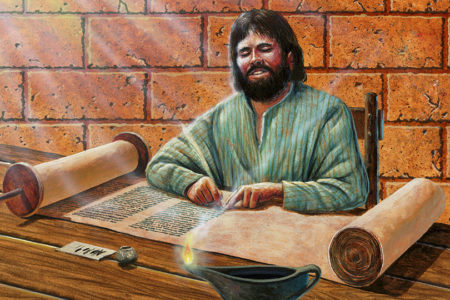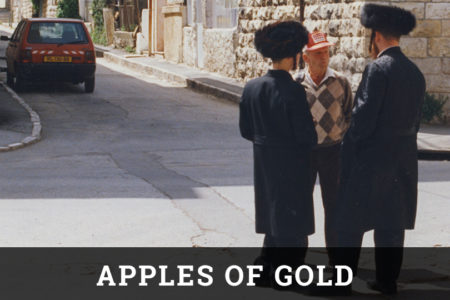A Portrait of the Messiah
With the shadow of the cross shading their minds, two of Christ’s disciples left Jerusalem. They were headed for Emmaus, a village seven miles from the city. Although it was relatively close to the Holy City, Emmaus would take them out of range of scenes of the catastrophic events of the past week. We are not told exactly why they chose to leave the company of the disciples after receiving news that the Savior had risen from the dead. We do know their state of mind and heart as they forlornly commiserated about shattered dreams of the golden millennial era—dreams their hopes had soared to seize during the days of Jesus’ earthly ministry.
Luke 24:14–15 tells us that “they talked together of all these things which had happened. And … communed together and reasoned.” But reasoning and discussion, however earnest or extended, only deepened their confusion. Gripped by doubts in their shaken beliefs, and understandably haunted by fears for their future, the disciples made their way down the road to Emmaus, perhaps hoping for retreat and rest as they began to restructure their lives.
When Jesus Himself drew alongside them, Scripture relates that the downcast disciples were kept from recognizing who He was. Why? Obviously, Jesus’ purpose reached beyond the moment. He was creating a situation that would ultimately open their eyes to who He was. But of inestimable importance was the fact that He was preparing the way for eyes to be opened across centuries yet unborn.
Christ’s conversation with the Emmaus-bound disciples yields the definite impression that, like their apostle contemporaries, they had exercised selective hearing during the months of instruction they received from Him. He upbraided them as foolish men who possessed hearts slow to believe. Evidently, they were so caught up in the swirl of events, throngs, and messianic fervor possessing the masses that they were not as attentive as they should have been to the instructions He was giving them. They had witnessed great miracles, but miraculous activity in itself was insufficient preparation for what they now faced. Crowds had marveled at His words and deeds. Even His enemies had declared that “Never man spoke like this man” (Jn. 7:46). This, however, was not enough to sustain them in their time of testing.
Soon enough, Jesus made Himself known in the breaking of the bread. “And it came to pass, as he sat eating with them, he took bread, and blessed it, and broke it, and gave it to them. And their eyes were opened, and they recognized him” (Lk. 24:30–31). As supernaturally as their eyes had been closed, they were now opened—opened at a strategic juncture in the encounter, opened to irrefutable evidence of the fulfillment of His prophecy that His body would be broken, His blood would be shed. Before His death, the record shows that “From that time forth began Jesus to show unto his disciples, how he must go unto Jerusalem, and suffer many things from the elders and chief priests and scribes, and be killed, and be raised again the third day” (Mt. 16:21).
Within hours, He amplified the physical evidence in their presence, along with the eleven in Jerusalem, as He displayed His resurrection body. “Behold my hands,” He told them, “and my feet, that it is I myself handle me, and see; for a spirit hath not flesh and bones, as ye see me have. And when he had thus spoken, he showed them his hands and his feet. And while they yet believed not for joy, and wondered, he said unto them, Have ye here anything to eat? And they gave him a piece of a piece of a broiled fish, and an honeycomb. And he took it, and did eat before them” (Lk. 24:39–43).
There could be no doubt about it: Jesus, the Christ, had physically risen from the dead, as He said He would. But, of itself, this momentous fact did not seem to flesh out the entire portrait of the Messiah/Savior that our Lord had determined to deliver.
Practicing What He Preached
In John chapter 5, Jesus presented four credible witnesses of His Messiahship to His priestly adversaries. John the Baptist was the first. Second, His own works, He told them, bore eloquent testimony to His proper identity. Buttressing those witnesses was the very word of the Father Himself. Finally, our Lord admonished His foes to “Search the scriptures; for in them ye think ye have eternal life; and they are they which testify of me … For had ye believed Moses, ye would have believed me; for he wrote of me” (Jn. 5:39, 46).
On the road to Emmaus, Jesus did not open the disciples’ eyes to His identity until He had fully exposed them to the witness of Moses and the prophets. Indispensable to the whole of the redemptive process was the fact that His life, death, and resurrection were the very embodiment of the portrait of the Messiah set forth in the Old Testament Scriptures. “O foolish ones, and slow of heart to believe all that the prophets have spoken! … And beginning at Moses and all the prophets, he expounded unto them, in all the scriptures, the things concerning himself” (Lk. 24:25, 27).
In his subsequent appearance to them and the other disciples in Jerusalem, Jesus once again practiced what He had preached to His adversaries, as He led the awe-smitten believers in a detailed exposition of the Old Testament messianic passages. “And he said unto them, These are the words which I spoke unto you, while I was yet with you, that all things must be fulfilled, which were written in the law of Moses, and in the prophets, and in the psalms, concerning me … And [He] said unto them, Thus it is written, and thus it behooved Christ to suffer, and to rise from the dead the third day; and that repentance and remission of sins should be preached in his name among all nations, beginning at Jerusalem. And ye are witnesses of these things” (Lk. 24:44, 46–48).
Three important propositions rise out of the text: (1) The Old Testament prophecies concerning the Messiah; (2) Jesus’ physical resurrection as the supreme certification of His credentials as the Messiah; and (3) the witness of the disciples to the reality of His resurrection, and the subsequent witness of the Church during the age of grace.
Sandwiched between these verses is a revelation of the utmost importance: “Then opened he their understanding, that they might understand the scriptures” (Lk. 24:45). As Jesus had supernaturally opened the eyes of the disciples to His physical identity, He now opened their minds to the truths of the Scriptures that reveal His prophetically ordained identity. So, forecast and fact fuse in the perfection of the person and work of Christ. In the fullest possible sense, they were illumined and led into the Holy of Holies as they comprehended the staggering fact that “the Word was made flesh, and dwelt among us” (Jn. 1:14).
Before many more years rolled by, the disciples were in heaven, removed from the earthly scene, but their witness is firmly secured for us in the New Testament record. And, as He commanded, we herald their message and ours to the ends of the earth. That message, however, still rests securely on the foundation laid in Moses, the prophets, and the Psalms. Paul, inspired by the Spirit of God, drove the point home “that Christ died for our sins according to the scriptures; And that he was buried, and that he rose again the third day according to the scriptures” (1 Cor. 15:3–4). That is, Paul said emphatically, “the gospel which I preached unto you, which also ye have received, and in which ye stand; By which also ye are saved” (1 Cor. 15:1–2).
If we are to proclaim the gospel in all of its fullness, we should be prepared to present the messianic prophecies of the Old Testament in concert with the facts of the New. This is particularly important when speaking with Jewish people. Scripture refers to the blindness of the nation of Israel during this current age of grace. But it is not a blindness that cannot be penetrated by the truth. Learn a lesson from those travelers to Emmaus, whose blindness He dispelled. “Did not our heart burn within us, while he talked with us along the way, and while he opened to us the scriptures?” (Lk. 24:32). That’s Spirit-borne conviction. Then Jesus “opened … their understanding” about those scriptures (Lk. 24:45). That’s Spirit-induced comprehension.
If we are to be fully prepared to give to every man an answer for the hope that is within us, we must learn to paint a portrait of the Messiah as it has been rendered in the Old Testament Scriptures. Luke 24 gives an eloquent account of the fact that the substance of any witness for Christ must be the Word. And that life-giving Word will be quickened in hearts by the Holy Spirit.
Early in my Christian life, a friend gave me a listing of Old Testament prophetic passages and their New Testament fulfillments. Comparing Scripture with Scripture accelerated my growth as a believer. Over all of these years, I cannot think of a study that has been more profitable or stood me in better stead than the thoroughly biblical view of my Savior garnered from those passages. This issue of Israel My Glory is dedicated to assisting you in your study of “all the scriptures, [and] the things concerning himself” (Lk. 24:27).









Thank You, for the study on the Messiah’s Portrait- Israel, very, very interesting. Would love to study more SHALOM